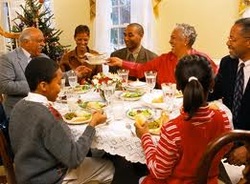 By Janice D’Arcy: The Washington Post Celebrating the holidays with children can be magical, sometimes. Other times, it can be a season of migraine-inducing family problems. We asked a few experts to sort out some of the most vexing, such as navigating expectations, handling family drama, teaching children gratitude and figuring out how to explain Santa. Here’s hoping this advice gets you more joy and less jaw-clenching during the next few weeks. Meredith Gelman, a Fairfax, VA-based clinical social worker who works with parents and families, said when parents have different ideas about gift-giving, the approach should be broken into three phases: creating a recipient list and budget, discussing each other’s expectations and reasons for giving, and negotiating. “Identify ways that you and your partner might combine each other’s gift ideas: Can you still buy at the toy store while also purchasing toys and clothing for a local needy family?” she said. She suggested involving children in the conversation, too, so they begin to understand the underlying reasons for giving gifts. Be sensitive about Santa.
If your family has children of mixed ages, keep the Santa Claus myth alive for the youngest, said Meghan Leahy, a D.C.-based parent coach. “You take the 4-year-old to pictures [with Santa], you write the list with her, you listen for the hoofs. As the parent, you use your imagination. “As much as a preteen would maybe love to get negative attention [for spoiling it], you simply hug him and say, ‘I believe in everything good about the holidays, and Santa is part of that in our house. Especially for your little sister,’ ” Leahy said. For families who celebrate Christmas without Santa, Leahy warned against asking a preschooler to keep the secret that there really isn’t a Santa. “It is a truism for all kids that if you look them in the eye and say, “Please, please don’t tell the kids in pre-K that there is no Santa,” that child will march right into school with an important announcement: “There is no Santa!” Instead, she said, “concentrate on what you do believe in as a family and say things like: ‘Some families believe in Santa, some don’t. We really believe in giving back in this house. Can you help me make a list of people we can help this holiday?’ You will notice that there was no refutation in that sentence. You simply want to highlight what the family values are.”
0 Comments
Leave a Reply. |
Archives
April 2018
Jude's Korean adventures
 MSTv Host/Producer: Jude Falcon MSTv Host/Producer: Jude Falcon
Alcohol in South Korea All bars and local night establishments are filled to the brim with things you have seen in all other places like Jack Daniels and Jagermeister. However you may spy a little green bottle with Korean writing on it and you may ask what is that? It's called Soju, my friends or 소주 for the Hangil inclined (Korean Language). Soju is a spirit primarily made from rice, barley, potatoes or tapioca and has an average alcohol content of 20% ABV however there are some brands of Andong Soju that are upward of 45% ABV. None the less, they will both get the job done. Soju has a taste very similar to vodka but it is slightly sweeter and easier to consume by itself. Now we get to the matter of cost and availability; however rest assured the answer will be qiute positive. Soju is available all over South Korea from the local convenience store for 1,000 Won = roughly $1 or in a restaurant for 3,000 Won =$3. So these adult treats certainly won't set you back any considerable amount. It alco mixes quite well with beer, cider, and energy drinks. Soju has been around since the 13th century and shows no signs of going anywhere anytime soon. So when you get the chance come on down to the Republic of South Korea and have a shot of deliciousness. Jude Falcon |
©MySceneTV - MSTv Productions, LLC | [email protected] | P 504.491.0254

 RSS Feed
RSS Feed
